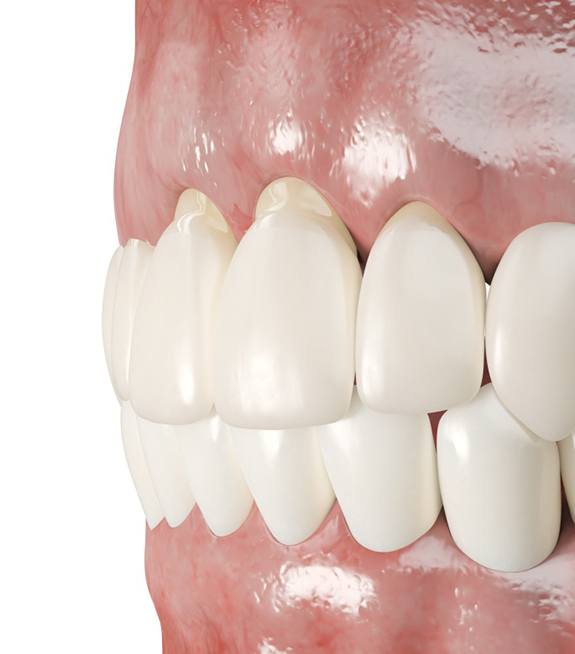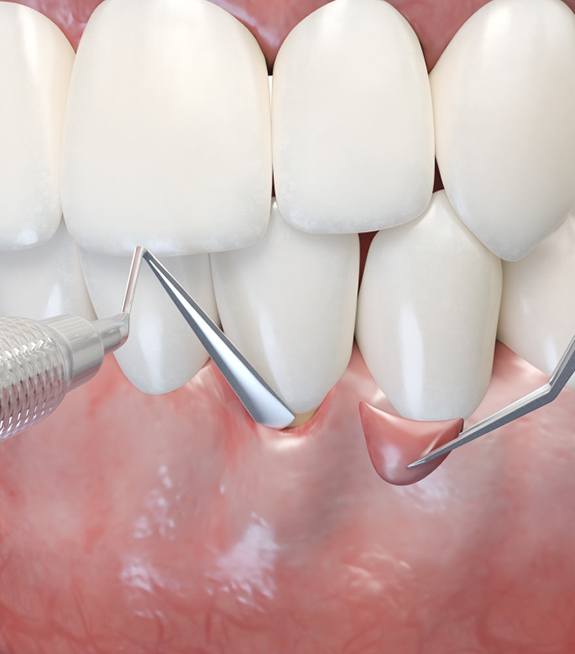Gum Grafting Corpus Christi
Turn Back the Clock on Gum Recession
Do your teeth look a little longer than they used to? This issue, known as gum recession, is extremely common among adults. The bad news is that lost gum tissue will not regrow on its own. The good news is that Dr. Garcia and the team at South Texas Periodontics & Implants are here to help. Gum grafting in Corpus Christi can help to turn back the clock on gum recession. Would you like to learn more about this restorative surgical procedure? Continue reading this page, and get in touch with us when you are ready to book your consultation.
Why Choose South Texas Periodontics & Implants for Gum Grafting?
- Highly Skilled Board-Certified Periodontist
- State-of-the-Art Technology
- Gain a Healthier and More Confident Smile
Why Does Gum Recession Occur?

The most common culprit behind gum recession is periodontal disease, which is also known simply as gum disease. In its earliest stages, this condition causes the gum tissue to become red, swollen, and inflamed. As it progresses, though, the bacteria that are responsible for it can cause serious damage to the underlying bone tissue. As the bone shrinks, the gums recede, and bacteria-filled pockets develop between the teeth and gums. If you have active gum disease, the infection will need to be addressed before your gum grafting surgery.
Of course, periodontal disease is not the only reason for gum recession. Other possible causes include:
- Teeth grinding and clenching (also known as bruxism)
- Overly aggressive brushing and flossing habits
- Lip and tongue piercing that can irritate sensitive soft oral tissues
- Malocclusion (a misaligned bite)
- Genetics
How Gum Grafting Works

Gum grafting is a surgical procedure that involves attaching new tissue to places where your gums have receded. As you heal from the procedure, your body should integrate the grafted tissue, allowing it to function as a natural and normal part of your smile.
There are three main types of gum grafts, including:
- A free gingival graft, which uses tissue from a patient’s own palate to thicken their gums.
- A subepithelial connective tissue graft, which aims to cover exposed tooth roots.
- An acellular dermal matrix allograft, which uses tissue donated from another source to fortify a patient’s gums.
Before your procedure, our team will take time to answer your questions about your surgery so you can go into it with confidence.
The Benefits of Gum Grafting

Some advantages that you may enjoy after you recover from your gum graft surgery include:
- A more attractive smile. Healthy, pink, appropriately sized gums can play an important role in your smile’s aesthetics.
- A reduced risk of cavities. Tooth roots do not have enamel to protect them from decay. When they are covered by your gums, they are safer.
- A reduced risk of gum disease. A gum graft can help to eliminate pockets between your gums and teeth so bacteria will not be able to thrive and cause damage.
- Less dental sensitivity. Exposed tooth roots can be extremely sensitive. Covering them will allow you to enjoy a greater variety of foods without pain.
- Long-lasting results. Your gum graft can provide you with many years of healthier smiles.
Gum Grafting FAQs
Is Gum Grafting Painful?
Gum grafting may sound intimidating since it involves dental surgery, but it’s not typically painful. Thanks to modern numbing agents and advanced pain management techniques, most patients feel little to no discomfort during the procedure. Afterward, some soreness and sensitivity are normal for a few days, but these symptoms are usually mild and manageable with recommended medications and care. Our team will ensure you stay as comfortable as possible throughout the process.
What Happens After Gum Grafting?
After gum grafting, you'll likely have gauze and a protective dressing in place. The gauze can usually be removed after about 30 minutes, while the dressing may fall out on its own within a few days or be taken off at a follow-up visit. If you received sedation, someone will need to drive you home. Our team will give you detailed aftercare instructions to help prevent pain or infection and support proper healing.
What’s the Gum Grafting Recovery Timeline?
The gum graft recovery timeline typically spans a few weeks, starting with rest and careful aftercare. On the first day, expect some bleeding, swelling, and discomfort. You can manage these side effects with prescribed medication, rest, and a soft food diet. By the first week, swelling and bruising should begin to subside, and you’ll gradually resume gentle oral care. By the second week, healing continues, and most patients feel more comfortable returning to normal routines as advised by their dentist.
What Are Gum Grafting Failure Symptoms?
Signs of gum graft failure include a large white patch of tissue that has detached from your tooth. Usually, this indicates the graft has lost blood supply and is no longer viable. Other warning signs include pus at the surgical site or a fever over 101°F (38.3°C). If you notice any of these symptoms or have concerns, contact your dentist right away for evaluation and treatment.
